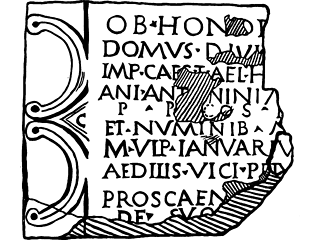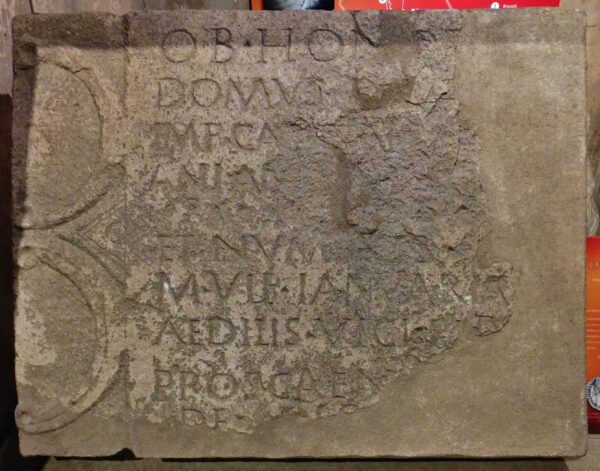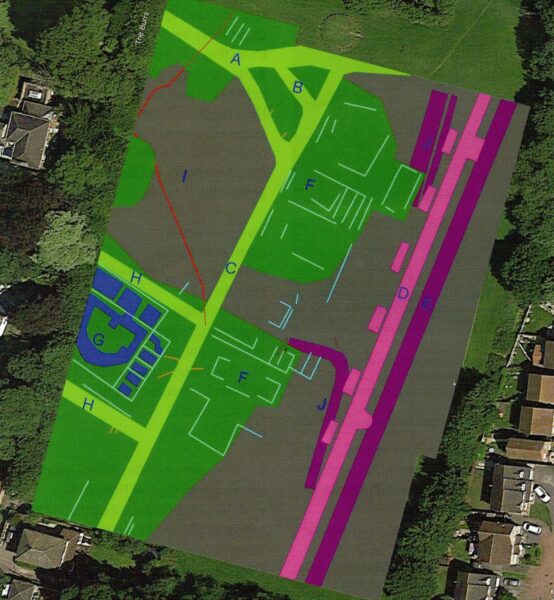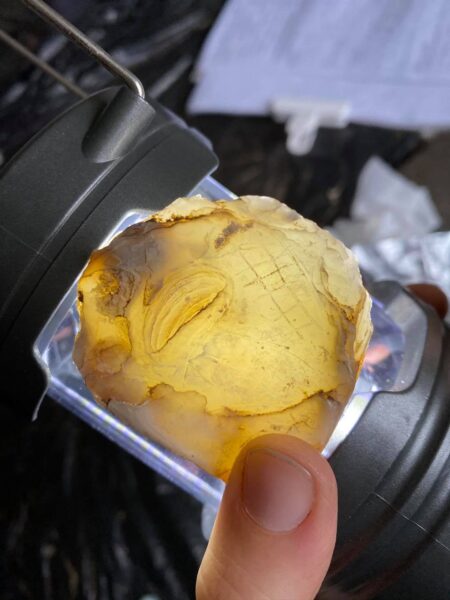
The Roman Theatre of Petuaria has so far been difficult to find, however according to The Petuaria Inscription it did exsist, and this stone was found on Burrs Playing Field in Brough, East Yorkshire.
Ptolemy, the 2nd century Roman geographer was the first writer to mention the town of Petuaria. He located it within the territory of the Parisi tribe – modern East Yorkshire.
The subsequent association of Petuaria with Brough-on Humber rests largely on an inscription unearthed in 1937 on the Burrs Playing Field. According to the excavator it was found ‘lying on end, as if it had fallen from a building when it collapsed, and showed no signs of having been re-used‘. This carved stone – that can be viewed in the Hull Museum – is illustrated in Figures 1 below and 2 above.

Parts of the inscription are damaged but, it is suggested that the full Latin text (with the addition of missing elements in square brackets) was as follows.
OB.HONOR[EM] DOMVS DIVI[NAE] IMP.CAES.T.AEL.H[ADRI] ANI.ANT[O]NINI A[VG] P. P. COS [ ? II or III] ET.NVMINIB.A[VG] M.VLP.IANVAR[I]V[S] AEDILIS.VICI.PETV[AR] PROSCAEN [ ̣ ̣ ̣] DE.[S]VO [DEDIT]
The Translation is:
For the honour of the divine house of the Emperor Caesar Titus Aelius Hadrianus Antoninus Augustus, father of his country, consul for the ?2nd/3rd time, and to the Divinities of the Emperors, Marcus Ulpius Januarius, aedile of the village of Petuaria, presented this stage at his own expense
Roman inscriptions have many characteristics in common. A typical form commences with the name of the person or persons to whom the dedication is made in addition to relevant details about them. Following this information is often provided explaining why the inscription was set up and by whom.
The Brough stone indicates that the inscription was dedicated to the Emperor Antonius Pius (138-161) providing his full name – IMP. CAES. T. AEL HADRI-ANI. ANTONINI. The letters AVG (Augustus), P.P (Patris Patriae – Father of his Country) and COS (Consul) furnish further details about the Emperor`s titles and honours acquired over the years and are very helpful in dating such inscriptions (in this case to between AD 140 and AD 144). The dedication was also made `ET NVMINIB AVG` – to the sprits of such former emperors as have been judged worthy of deification and memory.
The inscription then goes on to explain that a stage (proscaenium) was given by Marcus Ulpius Januarius at his own expense (de suo). There seems to be a missing word after PROSCAEN, and it is suggested that this could have been NOVUM (new) – in other words a new stage implying a replacement for something earlier.
Marcus Ulpius Januarius was a Roman citizen as indicated by the three elements of his name – a praenomen (Marcus), a nomen (Ulpius) and a cognomen (Januarius). He would have been given the name Marcus at nine days old and this, together with the `clan name` or nomen, Ulpius, shows that his family had first been granted citizenship under the Emperor Trajan (AD 98- 117; full name Emperor Marcus Ulpius Trajanus). Cognomens -such as Januarius – were originally a sort of family `nickname` passing down from father to son but, over time, they were used to augment the nomen, to identify a particular branch within a family or a clan.
On the inscription Marcus Ulpius Januarius is described as an aedile – or magistrate – for the vici (village) of Petuaria. In this position he would have been concerned with the maintenance of public buildings and amenities such as roads, drains and baths in addition to public order. It was a significant role that seems more important than would be expected for an official in a mere `village`. With this in mind it is suggested that the `C` in the left hand pelta of the inscription is not simply decorative but stands for `Civitas` with a missing `P` on the right side for `Parisiorum`. Marcus`s responsibilities might have extended beyond Petuaria covering the rest of the territory of the Romanised Parisi tribe too and even as far as Malton.

Today the key challenge remains finding any archaeological evidence for the theatre that Marcus supported back in the second century. Considerable excitement was generated by a ground-penetrating radar (GPR) survey undertaken in 2018 showing a D-shaped feature (marked G on Figure 3) within the same field that had produced the inscription. But, after two summers of excavations over the `D`, the theatre remains elusive albeit with some intriguing finds including an oyster shell adorned a chequer board and diamond pattern (Figure 4). Perhaps further work over the next few years – in Brough and the surrounding area – might finally solve the mystery of the missing theatre.

For more information on The Petuaria Inscription visit University of Hull: Lost Roman Town Discovered
Figure 1: The Petuaria Theatre Inscription ©Creative Commons
Figure 2: Drawing of the Petuaria Theatre Inscription ©Creative Commons
Figure 3: 2018 GPR survey of the Burrs Playing Field Brough ©David Staveley
Figure 4: Oyster shell with graffiti ©Nick Summerton
